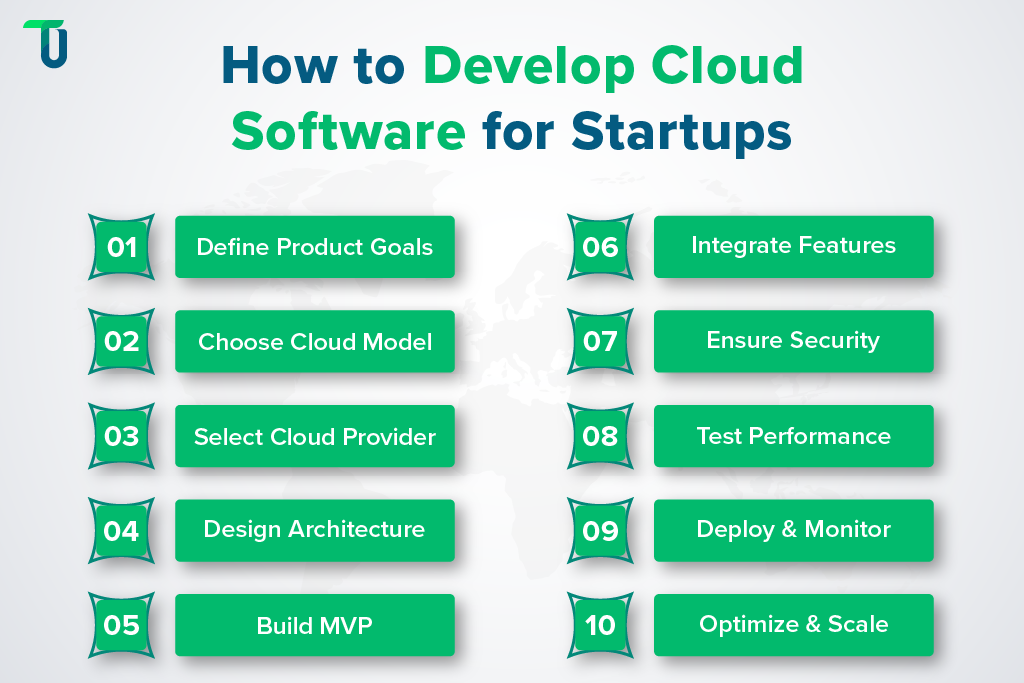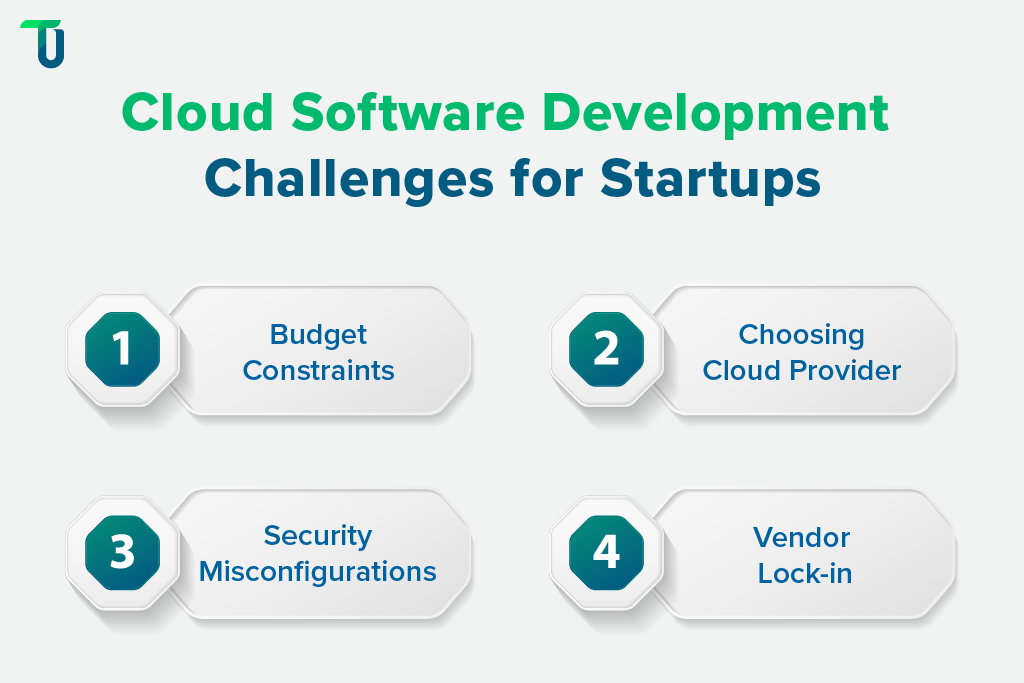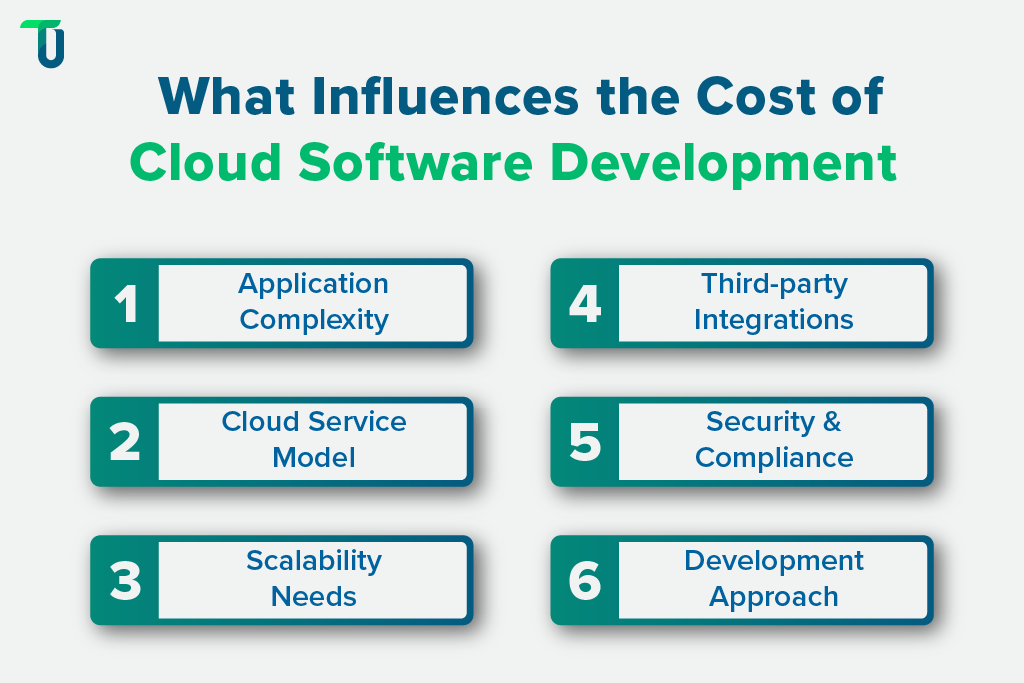Understanding Cloud Deployment Models
One of the first strategic decisions you’ll face as a founder is choosing the right cloud deployment model. The choice is not just technical, it determines how fast you can scale, how much control you retain, and how efficiently you manage costs.
IaaS, PaaS, and SaaS: What They Mean for Your Startup
- IaaS (Infrastructure as a Service): Best suited if you want maximum control over infrastructure without managing physical servers. It is like renting a data center that scales on demand. Startups building complex, custom applications often lean on IaaS for flexibility.
- PaaS (Platform as a Service): Ideal if your focus is rapid development and faster time-to-market. The provider manages infrastructure, runtime, and middleware so your team can concentrate on product features instead of maintenance.
- SaaS (Software as a Service): The model most users interact with daily. If your product vision is delivering software directly to customers with minimal setup, SaaS is your go-to. It handles updates, availability, and scalability out of the box.
Want a deeper dive into how these models compare in real-world use cases? Check out our blog on Comparing SaaS, PaaS, and IaaS for Cloud-Based Applications.
Choosing the Right Model for Your Business Needs
There is no one-size-fits-all answer here. If you are building a highly customized product that demands architectural control, IaaS makes sense. If speed and reduced overhead are top priorities, PaaS offers the right balance. And if your startup is designed to deliver a finished product directly to end-users, SaaS provides the shortest path to market.
The smart approach many startups take is a hybrid one, leveraging IaaS for core infrastructure, PaaS for development speed, and SaaS tools to support internal operations like CRM or analytics. What matters most is aligning the model with your product vision, customer expectations, and growth trajectory.
Don’t Let Cloud Adoption Overwhelm You
With a trusted partner like TenUp Software Services, you can build scalable, secure cloud software that drives real business outcomes.
Step-by-Step Process of Cloud Software Development for Startups
Successful cloud software development is not about jumping into coding right away. It is about building with strategy so your product can scale, stay secure, and meet customer expectations without draining capital. Here’s a proven step-by-step roadmap founders can follow:

1. Define Your Product Vision and Goals
Before you touch the cloud, get crystal clear on what you are building. This is not just about features, but about outcomes.
- Who are your users? Define your target audience, pain points, and use cases.
- What problem are you solving? This will guide the core functionality of your product.
- What does success look like? Set measurable goals like “acquire 10,000 users in 6 months” or “reduce operational costs by 30%.”
A strong vision prevents scope creep and ensures your cloud development efforts stay aligned with business strategy.
2. Choose the Right Cloud Model (IaaS, PaaS, SaaS)
Your deployment model dictates speed, flexibility, and cost.
- IaaS gives you control over infrastructure, perfect if you need customization.
- PaaS helps you move fast by handling backend services, ideal for early-stage startups that need to focus on product features.
- SaaS is the end-product model, best when you want to deliver directly to end-users with minimal setup.
Founders often underestimate this decision, but it impacts long-term scalability, cost, and your ability to adopt serverless cloud computing later. Take time to evaluate based on your product’s complexity, growth stage, and customer needs.
3. Select the Best Cloud Provider (AWS, Azure, GCP, etc.)
Not all providers are created equal. Here’s how to decide:
- AWS: Dominant in scalability and a huge marketplace of services.
- Azure: Great if you are targeting enterprises or already using Microsoft products.
- GCP: Strong for startups building data-driven or AI-first products.
Look at pricing, global availability zones, managed services, and startup credits before locking in a provider. Many founders start with one provider and later regret vendor lock-in, which is why many turn to cloud consulting services to avoid costly mistakes.
4. Design the Architecture (Cloud-Native vs. Cloud-Enabled)
Your architecture determines how resilient and scalable your product will be, which is why investing early in a well-structured scalable cloud architecture can save startups from costly rebuilds later.
- Cloud-native architecture is built to leverage the cloud fully with microservices, containers, and serverless functions. This makes scaling effortless, and adopting cloud application development with microservices helps startups build scalable, resilient systems from the ground up.
- Cloud-enabled architecture is when you lift-and-shift an app to the cloud without redesigning it. It works for quick MVP launches but limits long-term flexibility.
For startups, investing in cloud-native design early often pays off by avoiding costly rebuilds down the line.
5. Build an MVP (Minimum Viable Product)
The golden rule for startups: build lean, test fast.
- Launch with only the essential features that validate your idea.
- Use managed services like Firebase, AWS Lambda, or Azure App Services to cut time-to-market.
- Collect user feedback and adjust quickly before investing heavily in development.
The cloud’s pay-as-you-go model makes MVP development cheaper and faster than ever.
6. Develop and Integrate Features Iteratively
Once the MVP proves demand, move to iterative development.
- Use Agile + DevOps in cloud development practices to release features in sprints.
- Integrate third-party APIs to extend functionality without reinventing the wheel.
- Enable continuous integration and continuous deployment (CI/CD) pipelines so updates roll out faster.
This is where cloud development shines. Instead of waiting months for new releases, your startup can push updates weekly or even daily.
7. Ensure Security, Compliance, and Data Protection
Security is not optional. Founders often assume the provider handles it all, but responsibility is shared.
- Implement identity and access management (IAM) to control who can access what.
- Encrypt data at rest and in transit.
- Stay compliant with regulations like GDPR, HIPAA, or SOC 2 if you plan to target enterprise clients.
A single security misstep can break customer trust, so bake security into your cloud software development process from day one. This is especially important during custom cloud migration strategy for startups, where security gaps often appear.
8. Test for Performance and Scalability
Don’t wait until users complain to test your app’s performance.
- Run load testing to simulate thousands of users.
- Identify bottlenecks in your architecture.
- Use auto-scaling features from providers to handle traffic spikes.
Performance testing ensures your product can handle growth without crashing at a critical moment, like after a major launch.
9. Deploy and Monitor on the Cloud
Deployment is not the end, it is the beginning of real usage.
- Use CI/CD pipelines to automate deployments.
- Monitor uptime, error rates, and latency using tools like AWS CloudWatch, Azure Monitor, or GCP Operations Suite.
- Set alerts so your team can respond to issues before users even notice them.
Monitoring is your safety net. It helps you make decisions based on real-time data instead of assumptions.
10. Optimize and Scale as You Grow
Scaling smartly is the biggest advantage of cloud software development.
- Use auto-scaling and load balancing to manage traffic without overspending.
- Adopt FinOps practices and use cloud cost monitoring metrics to track and optimize cloud spend.
- Expand globally by deploying to multiple regions for low latency and compliance needs.
Scaling is not just about handling more users. It is about doing so cost-effectively while maintaining performance and security.
Best Practices for Cloud Software Development
Even with the right roadmap, execution can fail if you overlook the fundamentals. The best practices below are what separate startups that scale seamlessly from those that struggle with cost overruns and reliability issues.
1. Start Small, Scale Fast
Do not over-engineer your product in the early stages. Begin with the minimum resources needed to validate your idea, then scale as adoption grows. Cloud development allows you to provision resources instantly, so you don’t need to pay for capacity you don’t yet need.
2. Automate with DevOps and CI/CD
Automation is a growth multiplier. By implementing DevOps in cloud development pipelines and CI/CD practices, you ensure faster releases, fewer manual errors, and smoother collaboration between developers and operations — an approach strengthened by cloud consulting services to accelerate DevOps. In cloud software development, automation is not a luxury, it is a necessity for speed and stability.
3. Use Serverless Where Possible to Cut Costs
Serverless cloud computing eliminates the need to manage infrastructure and lets you pay only for what you use. For startups, this means lower costs, less overhead, and the ability to focus entirely on product innovation. Functions-as-a-Service (like AWS Lambda or Azure Functions) are powerful tools to maximize efficiency.
4. Prioritize Monitoring and Analytics
Your product should never operate blindly. Monitoring tools help you track uptime, performance, and usage trends. Analytics provide insights into how users interact with your application, allowing you to make data-driven decisions. In the context of cloud development, cloud cost monitoring metrics are essential for cost control and proactive scaling.
Challenges Startups Face in Cloud Software Development
Cloud is a game-changer for startups. It offers speed, flexibility, and lower upfront costs compared to traditional infrastructure. But here’s the reality most founders discover quickly: cloud software development comes with its own set of hurdles. If you don’t plan for them, these challenges can eat into your budget, slow down growth, and even put your product at risk. Let’s break down the most common issues and how to tackle them.

1. Budget Constraints
For startups, every dollar counts. Cloud’s pay-as-you-go pricing sounds perfect until the first bill arrives. Many teams over-provision resources “just in case” or forget to turn off test environments, and costs balloon faster than expected.
- Founder’s Reality: You might expect to pay $1,000 a month, only to see bills hitting $5,000 because of unused storage, idle servers, or unexpected traffic spikes.
- Why It Happens: Lack of visibility into usage, no budget guardrails, and no cost-optimization strategy.
- Quick Fix:
- Implement FinOps practices early, treat cloud costs like you would any other financial metric. Use provider tools like AWS Cost Explorer or Azure Cost Management to track spend in real time, and explore how automation in cloud cost optimization helps eliminate waste and keep budgets under control.
- Use provider tools like AWS Cost Explorer or Azure Cost Management to track spend in real time.
- Automate resource scaling so you pay only for what you use.
- Set alerts to flag unusual spikes before they hurt your runway.
With cloud development, discipline around budgeting can be as important as coding quality. Early adoption of FinOps cloud cost optimization prevents overspending and keeps cloud budgets healthy.
2. Choosing the Right Provider
The “big three” (AWS, Azure, GCP) all offer robust platforms, but choosing blindly can limit flexibility and increase costs down the line.
- Founder’s Reality: A startup building an AI-first product might choose Azure for its enterprise integrations, only to realize later that GCP offers more affordable and specialized AI services.
- Why It Happens: Providers have overlapping offerings, but the strengths of each vary. AWS excels in scalability, Azure in enterprise adoption, and GCP in analytics and AI. Many founders choose based on brand recognition instead of aligning with product needs.
- Quick Fix:
- Run pilot projects on two providers before fully committing.
- Compare total costs of ownership, not just headline pricing.
- Explore startup credits; all three providers offer free credits that can save thousands in early stages.
- Think long-term: choose a provider whose strengths align with your roadmap (e.g., AI, IoT, enterprise customers).
In cloud software development, the right provider is less about size and more about strategic fit.
3. Security Misconfigurations
One of the biggest risks in cloud development is assuming the provider “handles everything.” Cloud security operates on a shared responsibility model, where the provider secures the cloud, while you are responsible for securing your applications, data, and configurations.
- Founder’s Reality: A simple oversight, like leaving an S3 bucket public, has led to data leaks at even well-funded startups. For a small business, one such mistake can destroy customer trust.
- Why It Happens: Startups often move fast, skipping proper security reviews in the race to launch. Limited budgets also mean fewer dedicated security resources.
- Quick Fix:
- Implement Identity and Access Management (IAM) to control who can access what.
- Encrypt all sensitive data at rest and in transit.
- Run regular security audits and use tools like AWS Trusted Advisor or Azure Security Center.
- Train developers on secure coding practices for cloud software development.
Security is not a feature you add later; it is a foundation for customer trust and enterprise readiness.
4. Vendor Lock-In
While going “all-in” on one cloud provider can speed up development, it also creates dependency. Migrating away later can be expensive, time-consuming, and disruptive.
- Founder’s Reality: A SaaS startup deeply embedded in AWS services may later struggle when enterprise clients request multi-cloud deployments for compliance reasons. The cost of rewriting architecture at that stage can run into hundreds of thousands.
- Why It Happens: Providers design services to work best within their ecosystem, which makes startups dependent on proprietary tools. Early choices may limit future flexibility.
- Quick Fix:
- Design your architecture with portability in mind. Use containers (Docker, Kubernetes) to run workloads across multiple clouds.
- Favor open-source solutions where possible to avoid being locked into proprietary services.
- Adopt a multi-cloud or hybrid strategy if compliance or resilience is critical to your business model.
- Keep exit costs in mind while designing your product.
Founders who consider lock-in risks early in their cloud development journey save themselves from painful migrations later.
Cost of Cloud Software Development for Startups
One of the first questions founders ask is, “How much will it cost to build and run our cloud software?” The truth is, there’s no single number. The cost of cloud software development depends on multiple moving parts, from the scope of your application to whether you choose a cloud-native vs cloud-based application approach, along with the infrastructure choices you make. Understanding these factors early helps you budget smartly and avoid expensive surprises later.
Factors That Influence Cost
Whether you need custom cloud software development or enterprise-grade scalable cloud solutions, your cost will depend on scope and architecture choices. Several elements drive the total cost of cloud development:

- Complexity of the Application: A simple MVP with core features is cheaper than a full-fledged product with AI, integrations, and advanced analytics.
- Cloud Service Model: Choosing between IaaS, PaaS, and SaaS is often the first step in any cloud application development or custom cloud software development journey. For instance, PaaS reduces infrastructure management costs but may limit flexibility.
- Scalability Needs: If your app must support thousands of concurrent users from Day 1, you’ll pay more for infrastructure than a startup rolling out gradually.
- Third-Party Integrations: APIs for payments, messaging, or AI services often carry usage-based costs.
- Security and Compliance: Startups in fintech, healthtech, or edtech must allocate budget for stricter compliance requirements like GDPR or HIPAA.
- Development Approach: Hiring in-house teams, outsourcing, or using hybrid models all come with different cost structures.
Budgeting Tips for Early-Stage Startups
Getting cloud software development right doesn’t mean overspending. Here’s how to stay lean while building for growth:
- Start with an MVP: Resist the temptation to build everything at once. Focus on your differentiator, then iterate based on user feedback.
- Choose the Right Cloud Model: PaaS may help early-stage startups save on DevOps costs, while IaaS offers more control for scaling later.
- Use Pay-As-You-Go Services: Most cloud providers let you pay only for what you use. This keeps upfront costs low.
- Leverage Open-Source Tools: Instead of licensing expensive proprietary software, use open-source frameworks to cut costs without sacrificing quality.
- Outsource Smartly: Partnering with a cloud development team can be cheaper and faster than hiring full-time engineers early on.
Optimizing Cloud Spend with FinOps
Even after your product launches, keeping costs under control is an ongoing process. This is where FinOps (Cloud Financial Operations) comes in.
FinOps helps startups align engineering, finance, and product teams to manage cloud spend efficiently. With real-time visibility into usage, you can:
- Identify and shut down unused resources.
- Right-size instances to avoid overprovisioning.
- Set budgets and alerts to prevent bill shocks.
- Continuously balance cost, performance, and speed of delivery.
Early adoption of FinOps isn’t just about saving money. It builds a culture of accountability around cloud spend, ensuring every dollar invested in cloud software development drives measurable business value.
Proven Cloud Outcomes: Stories of Growth and Transformation
Talking theory is easy, but what matters is impact. At TenUp, we have helped startups and enterprises scale faster and smarter with cloud software development. Here are some client stories that show how cloud solutions drive growth.
Case Study 1: Building a New Cloud-Native App
A US-based enterprise wanted to modernize its application landscape by shifting from monolithic systems to a scalable cloud-native environment. The goal was clear: reduce technical debt, enable faster time-to-market, and support long-term scalability.
Business Need: Replace legacy monolithic app, enable containerized deployments, integrate CI/CD pipelines, and ensure high scalability on cloud.
Solution: Designed and built a cloud-native development environment using React.js, Node.js, Docker, Kubernetes, and Jenkins CI/CD, deployed on AWS cloud for elasticity and cost-efficiency.
Benefits: 40% reduction in time-to-market, improved scalability for peak loads, and faster rollouts with automated CI/CD pipelines.
Case Study 2: Unlocking Growth with AWS
A global SaaS provider faced challenges scaling its platform to serve growing enterprise clients. Infrastructure costs were rising, performance was inconsistent, and manual processes slowed growth. The goal was to achieve agility and optimize spend.
Business Need: Scale infrastructure efficiently, improve performance, cut down rising costs, and streamline operations with automation.
Solution: Migrated workloads to AWS with an optimized architecture using EC2, RDS, S3, and CloudFormation templates, plus implemented auto-scaling, CloudWatch monitoring, and IAM for access control. This transformation was possible through expert cloud consulting services.
Benefits: 50% cost optimization, enhanced platform stability with 99.95% uptime, and accelerated user onboarding with automation.
Case Study 3: Streamlining Real Estate Agent Booking & Workflows
A Chicago-based real estate brokerage needed to simplify booking tasks for busy agents. Previously, this process involved manual steps and inefficiencies. The ask was to automate, streamline, and scale.
Business Need: Real-time sub-agent availability, MLS filtering, task assignment automation, and integrated payments
Solution: Developed a mobile-first CRM using Flutter, Postgres, Spring Boot (Java 11), MLS Grid API, Stripe payments, Firebase notifications, hosted on AWS EC2.
Benefits: 3× increase in productivity, 99.99% system uptime, seamless payment handling, and near-elimination of manual steps.
Why Is TenUpSoft the Right Cloud Partner for Your Start-Up?
Choosing a cloud partner is not just about technology; it is about trust, expertise, and long-term impact. At TenUp Software Services, we don’t just migrate apps or build solutions; we engineer outcomes. Our team blends strategy with execution to ensure your cloud journey is smooth and future-ready.
Here’s why enterprises and startups trust us with their cloud solutions:
- Proven Impact: From real estate to SaaS to large-scale platforms, our cloud solutions deliver measurable business results.
- End-to-End Cloud Expertise: Cloud-native app development, modernization, integration, and managed services, everything under one roof.
- Agility at Scale: We build flexible, scalable cloud solutions tailored to your growth stage, whether you are a fast-growing startup or an enterprise.
- Future-Focused Innovation: We leverage modern stacks, automation, and AI/ML to keep you ahead of the curve.
- Client-First Approach: Your success is our benchmark. Every engagement is designed around business outcomes, not just technology deliverables.
At TenUpSoft, we don’t just take you to the cloud — we provide tailored cloud consulting services, guide cloud migration for startups, and build scalable cloud solutions that support long-term growth. We help you stay competitive, resilient, and ready for what is next with the right cloud solution.
Don’t Let Legacy Hold You Back
Move faster, smarter, and safer with our cloud solutions, tailored to your specific needs and goals. Talk to our experts today.
Frequently asked questions
What makes a ‘cloud-native development’ startup-ready versus lift-and-shift cloud migration?
Cloud-native apps use microservices, containers, and serverless tech to scale and adapt quickly—perfect for startups. Lift-and-shift is faster and cheaper upfront but limits agility, scalability, and long-term cost efficiency.
What hidden costs should founders watch for when launching an MVP in the cloud?
Hidden costs often come from idle servers, storage growth, third-party API fees, and sudden usage spikes. Startups should set budget alerts, monitor integrations, and automate resource scaling to prevent overspending.
How can startups mitigate vendor lock-in while benefiting from a single cloud provider?
Startups can reduce lock-in by building with containers, open-source tools, and loosely coupled microservices that run across environments. Keeping data in portable formats and using abstraction layers ensures they stay flexible, while still gaining the cost and speed benefits of a single provider.
Which cloud provider (AWS, Azure, GCP) offers the best startup credits and growth tools?
AWS Activate gives up to $100K in credits with the widest cloud ecosystem, Azure provides up to $150K plus enterprise and Microsoft integrations, and GCP offers up to $200K with strong AI/ML and data tools. The “best” choice depends on your startup’s roadmap, tech stack, and scaling needs.
When is it smarter to invest in cloud consulting services versus building in-house expertise?
Consultants are ideal for early setup, migrations, or compliance where mistakes are expensive. As a startup scales, moving to in-house talent offers more control, continuity, and long-term cost efficiency.
What are the must-have security protocols for startups during cloud migration?
Startups should enforce strong IAM with MFA, encrypt data in transit and at rest, and follow compliance standards like GDPR or HIPAA. Continuous monitoring and regular audits ensure breaches are prevented and customer trust is maintained.
How do DevOps practices improve cloud software development velocity for startups?
DevOps speeds up development by automating testing, integration, and deployments through CI/CD pipelines. This reduces errors, shortens feedback loops, and helps startups release features faster while improving software quality.
When should a startup transition from cloud-enabled to cloud-native architecture for scalability?
A startup should shift once user demand outpaces performance or scaling costs climb. Cloud-native’s microservices and automation enable seamless growth, avoiding costly rebuilds and ensuring long-term agility.

